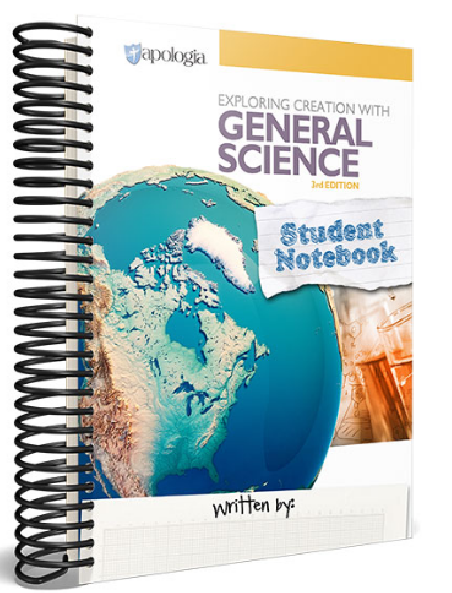- Pre-Order NOW- We ANTICIPATE STOCK end of JULY 2024


This notebook pairs perfectly with the Exploring Creation with General Science, 3rd Edition textbook, providing easy-to-understand graphics where students fill in the blank spaces as they read. Students learn how to take information from a text, identify key points, and critically think through what they are learning.
Teaching Your Student Solid Note-Taking Skills
Note-taking is a learned skill. While it might seem like there should be “answers” to questions and prompts found in the student notebook, specific answers are not provided on purpose. The best way to take notes is the way that works for the student. That’s why the Student Notebook introduces the student to several methods for taking notes. At the beginning of each module in their Student Notebooks, students are encouraged to take mindful notes using techniques that expand as the school year progresses.
The section in the Student Notebook where notes are recorded was created to give students prompts or questions to lead them to the important information they will read in the text. Answering these prompts will help them take effective notes. The notes a student takes are personal to them and their answers may be different from another student’s answers, but they can be sure to find the information on the pages they’re instructed to read.
Although there is no one right way to take good notes, after trying the techniques in this notebook students should find the way that works best for them. Then they’ll have a much better handle on all the interesting and sometimes amazing things they will learn in general science this year.
Additionally, the course is purposely designed so that the first 2 exams are open book – meaning that students can use their textbook and notebooks when answering questions. Students are encouraged to evaluate their note taking efforts after each exam. Were their notes helpful in the exam? If yes, they are capturing important information. If no, they need to learn to pull more information out of the textbook. Don’t worry, the text helps them there too. Using coloured text and prompts to steer them in the right direction, the student is essentially walked through the note-taking experience.
The General Science Student Notebook Includes:
Additional Note-Taking Tips for Your Student
The Student Notebook also includes tips for writing good notes. Here are just some tips for writing good notes that students will be introduced to in this notebook:
Parents are encouraged to review their student’s notebook to make sure that the student is properly engaged, however, student notes should never be graded. You can choose to use the character-building points in your evaluations. Offer encouragement if you see your student struggling. Ask them to review with you what they are learning. Mentor to them how you took notes at their age. You will see that with each notebook module we offer tips and hints. By the time your student finishes the course, you’ll see highlighting and coloured fonts, personal thoughts expanded and explored, and a true knowledge on how to personalize, capture, and understand new knowledge.
You might also like
Creation Magazine
Issue 46:2
Journal of Creation
Issue 38:1

